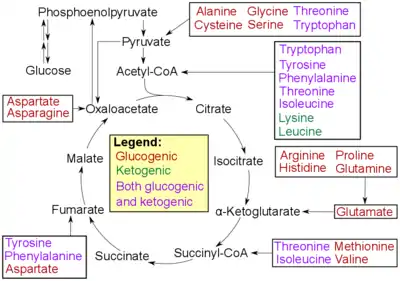Glucogenic amino acid
A glucogenic amino acid (or glucoplastic amino acid[1]) is an amino acid that can be converted into glucose through gluconeogenesis.[2][3] This is in contrast to the ketogenic amino acids, which are converted into ketone bodies.

Summary of amino acid catabolism
The production of glucose from glucogenic amino acids involves these amino acids being converted to alpha keto acids and then to glucose, with both processes occurring in the liver. This mechanism predominates during catabolysis, rising as fasting and starvation increase in severity.
In humans, the glucogenic amino acids are:
- Alanine
- Arginine
- Asparagine
- Aspartic acid
- Cysteine
- Glutamic acid
- Glutamine
- Glycine
- Histidine
- Methionine
- Proline
- Serine
- Valine
Amino acids that are both glucogenic and ketogenic (mnemonic "PITTT"):
Only leucine and lysine are not glucogenic (they are only ketogenic).
References
- Müller, M. J.; Seitz, H. J. (1984). "Thyroid hormone action on intermediary metabolism. Part III. Protein metabolism in hyper- and hypothyroidism". Klinische Wochenschrift. 62 (3): 97–102. doi:10.1007/BF01738699. PMID 6231411. S2CID 2598447.
- Brosnan J (1 June 2003). "Interorgan amino acid transport and its regulation". J Nutr. 133 (6 Suppl 1): 2068S–2072S. doi:10.1093/jn/133.6.2068S. PMID 12771367.
- Young V, Ajami A (1 September 2001). "Glutamine: the emperor or his clothes?". J Nutr. 131 (9 Suppl): 2449S–59S, discussion 2486S–7S. doi:10.1093/jn/131.9.2449S. PMID 11533293.
External links
- Amino acid metabolism
- Chapter on Amino acid catabolism in Biochemistry by Jeremy Berg, John Tymoczko, Lubert Stryer. Fourth ed. by Lubert Stryer. ISBN 0-7167-4955-6 Accessed 2007-03-17
- Amino acid metabolism
This article is issued from Wikipedia. The text is licensed under Creative Commons - Attribution - Sharealike. Additional terms may apply for the media files.
